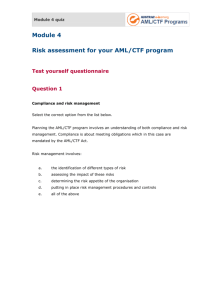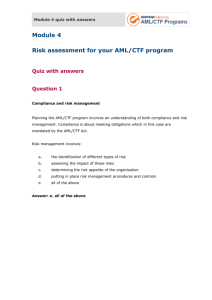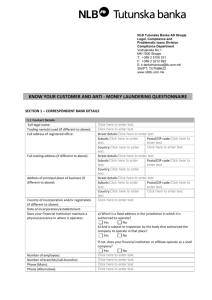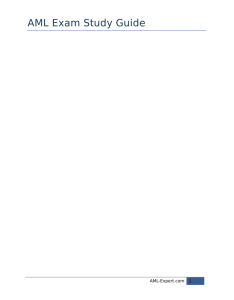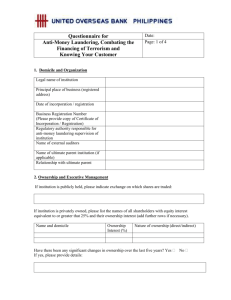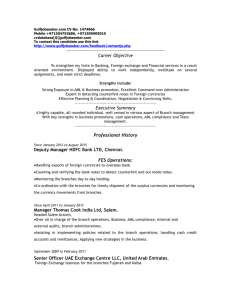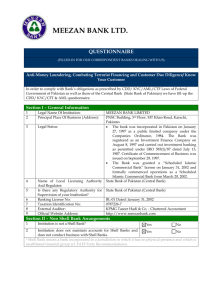Correspondent banking (Word, 212KB)
advertisement
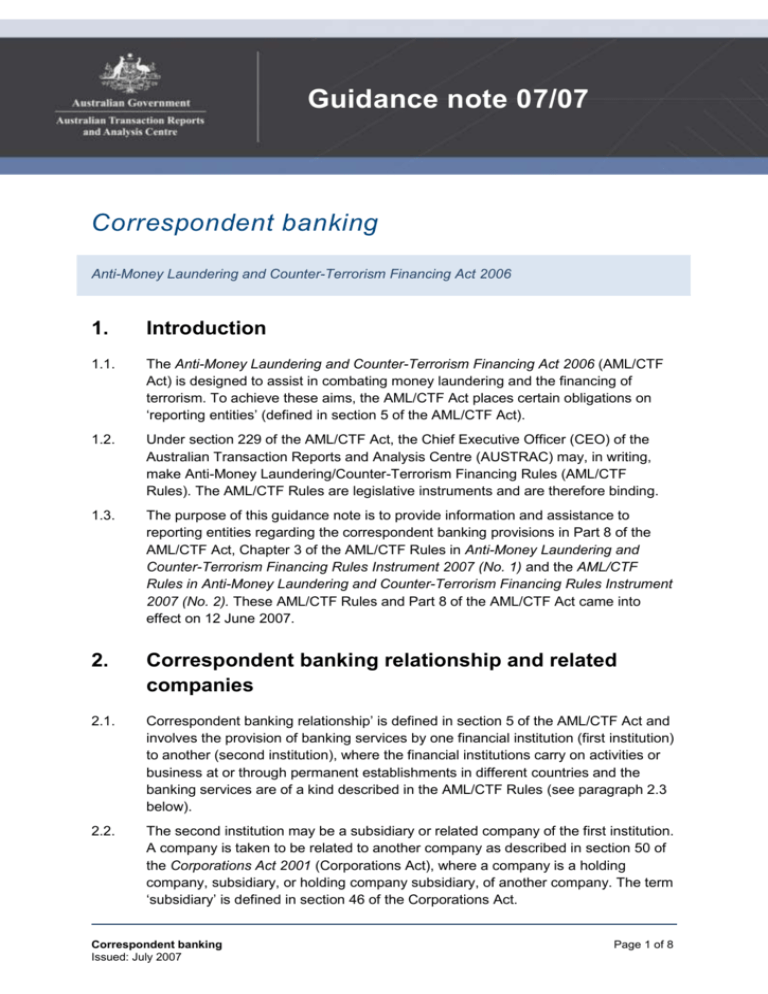
Guidance note 07/07 Correspondent banking Anti-Money Laundering and Counter-Terrorism Financing Act 2006 1. Introduction 1.1. The Anti-Money Laundering and Counter-Terrorism Financing Act 2006 (AML/CTF Act) is designed to assist in combating money laundering and the financing of terrorism. To achieve these aims, the AML/CTF Act places certain obligations on ‘reporting entities’ (defined in section 5 of the AML/CTF Act). 1.2. Under section 229 of the AML/CTF Act, the Chief Executive Officer (CEO) of the Australian Transaction Reports and Analysis Centre (AUSTRAC) may, in writing, make Anti-Money Laundering/Counter-Terrorism Financing Rules (AML/CTF Rules). The AML/CTF Rules are legislative instruments and are therefore binding. 1.3. The purpose of this guidance note is to provide information and assistance to reporting entities regarding the correspondent banking provisions in Part 8 of the AML/CTF Act, Chapter 3 of the AML/CTF Rules in Anti-Money Laundering and Counter-Terrorism Financing Rules Instrument 2007 (No. 1) and the AML/CTF Rules in Anti-Money Laundering and Counter-Terrorism Financing Rules Instrument 2007 (No. 2). These AML/CTF Rules and Part 8 of the AML/CTF Act came into effect on 12 June 2007. 2. Correspondent banking relationship and related companies 2.1. Correspondent banking relationship’ is defined in section 5 of the AML/CTF Act and involves the provision of banking services by one financial institution (first institution) to another (second institution), where the financial institutions carry on activities or business at or through permanent establishments in different countries and the banking services are of a kind described in the AML/CTF Rules (see paragraph 2.3 below). 2.2. The second institution may be a subsidiary or related company of the first institution. A company is taken to be related to another company as described in section 50 of the Corporations Act 2001 (Corporations Act), where a company is a holding company, subsidiary, or holding company subsidiary, of another company. The term ‘subsidiary’ is defined in section 46 of the Corporations Act. Correspondent banking Issued: July 2007 Page 1 of 8 2.3. The AML/CTF Rules in Anti-Money Laundering and Counter-Terrorism Financing Rules Instrument 2007 (No. 2) provide that the correspondent banking relationship definition only relates to banking services involving nostro or Vostro accounts. The terms ‘nostro’ and ‘vostro’ are not defined in the AML/CTF Act or AML/CTF Rules, but it is commonly held that a nostro (Latin for ‘ours’) account is an account a financial institution holds with a foreign financial institution, usually in the currency of the foreign country. A vostro (Latin for ‘yours’) account is the account a financial institution holds on behalf of a foreign financial institution. 3. Geographical links 3.1. Under section 100 of the AML/CTF Act, a financial institution is only subject to the provisions of Part 8 of the AML/CTF Act if it: a) carries on an activity or business at or through a permanent establishment in Australia (for example, an entity situated in Australia or an Australian branch of a overseas entity); or b) is a resident of Australia and carries on an activity or business at or through a permanent establishment in a foreign country (for example, a foreign branch of an Australian entity); or c) is a subsidiary of a company that is a resident of Australia and the financial institution carries on an activity or business at or through a permanent establishment in a foreign country (for example, an overseas subsidiary of an Australian entity). 3.2. A definition of ‘permanent establishment’ is in section 21 of the AML/CTF Act and includes provision for agents, mobile services and electronic communications. 4. Shell banks 4.1. Section 95 of the AML/CTF Act provides that a financial institution must not enter into a correspondent banking relationship reckless as to whether the other institution is a shell bank or has a correspondent banking relationship with a shell bank. 4.2. Section 15 of the AML/CTF Act defines ‘shell bank’ as a corporation that: a) b) c) d) is incorporated in a foreign country; and is authorised to carry on banking business in that country; and does not have a physical presence in its country of incorporation; and is not an affiliate of another corporation that, in a particular country, has a physical presence, is incorporated and is authorised to carry on banking business. 4.3. ‘Physical presence’ in a country, for the purposes of the shell bank definition, means the corporation carries on banking business at a physical place in that country and has at least one full-time employee who performs banking-related duties at that place. 4.4. Where a first institution is in a correspondent banking relationship and becomes aware that the second institution is a shell bank or has a correspondent banking Correspondent banking Issued: July 2007 Page 2 of 8 relationship with a shell bank, the first institution must terminate the relationship within 20 business days after gaining this awareness, or such longer period (if any) as allowed by the AUSTRAC CEO. See subsection 96(1) of the AML/CTF Act. 4.5. Alternatively, if applicable, the first institution can request the second institution to terminate its correspondent banking relationship with the shell bank. If, after 20 business days, the second institution has not complied with the request, the first institution must terminate its correspondent banking relationship with the second institution within a further 20 business days, or within such longer period (if any) as the AUSTRAC CEO allows. See subsections 96(2) and 96(3) of the AML/CTF Act. 5. Preliminary risk and due diligence assessments when entering into correspondent banking relationships 5.1. Subsection 97(1) of the AML/CTF Act requires that before the first institution enters into a correspondent banking relationship, it must carry out a preliminary assessment of the risk it may reasonably face that the relationship may involve or facilitate money laundering or the financing of terrorism. AUSTRAC expects that financial institutions’ actions will be consistent with prudent and good practice in carrying out the assessment and documenting its findings. 5.2. It may be necessary, under subsection 97(2) of the AML/CTF Act, for the first institution to then carry out a due diligence assessment, if warranted by the risk identified in the preliminary risk assessment. This must be carried out prior to entering into the correspondent banking relationship. The factors to be assessed are outlined below. A written record of the completed assessment must be prepared as soon as practicable. 5.3. The due diligence matters to be assessed by the first institution (relating to the second institution) are set out in paragraph 3.1.2 of Chapter 3 of the AML/CTF Rules, being: a) the nature of the second institution’s business, including its product and customer base; b) the country of residence (domicile) of the second institution; c) the country of residence of any parent company of the second institution; d) the existence and quality of any AML/CTF regulation in the second institution’s country of residence; e) the existence and quality of any AML/CTF regulation in the country of residence of any parent company of the second institution, where the parent company has group-wide controls within which the second institution operates; f) the adequacy of the second institution’s AML/CTF controls and internal compliance practices; g) the ownership, control and management structures of the second institution and any parent company, including whether a politically exposed person (refer to paragraph 8.6 below) has ownership or control of the second institution or parent company; h) the second institution’s financial position; i) the reputation and history of the second institution, including its business history and compliance history; Correspondent banking Issued: July 2007 Page 3 of 8 j) the reputation and history of any parent company of the second institution; and k) whether the second institution has been the subject of an investigation, or any criminal or civil proceedings relating to money laundering or terrorism financing. 5.4. Subsection 99(1) of the AML/CTF Act requires that a senior officer of the financial institution approve any correspondent banking relationship entered into. The senior officer must take into account the matters specified in Chapter 3 of the AML/CTF Rules as described above. ‘Senior officer’ does not only include a person in executive management. The financial institution can determine who is a senior officer, depending on the size and complexity of the organisation. 6. Regular risk and due diligence assessments after entering into correspondent banking relationships 6.1. Subsection 98(1) of the AML/CTF Act requires that after the first institution enters into a correspondent banking relationship, it must carry out regular risk assessments of the potential for the relationship to involve or facilitate money laundering or the financing of terrorism. 6.2. It may be necessary, under subsection 98(2) of the AML/CTF Act, for the financial institution to carry out regular due diligence assessments, if warranted by the results of a risk assessment. A written record of each completed due diligence assessment must be prepared as soon as practicable. 6.3. The due diligence matters to be assessed by the first institution (relating to the second institution) are set out in paragraph 3.1.4 of Chapter 3 of the AML/CTF Rules, being: a) the matters described in paragraph 5.3 above; b) any material changes in respect of the matters described in paragraph 5.3 above; c) the nature of the second institution’s ongoing business relationship with the first institution, including the types of transactions carried out as part of that relationship; and d) any material change in the nature of the second institution’s ongoing business relationship with the first institution, including the types of transactions carried out as part of that relationship. The first institution must have in place appropriate risk-based systems and controls to identify such changes. 7. Frequency of regular risk assessments 7.1. The frequency of carrying out regular risk assessments, after entering into a correspondent banking relationship, is set out in paragraph 3.1.5 of Chapter 3 of the AML/CTF Rules. 7.2. If the first institution enters into a correspondent banking relationship after the commencement of section 98 of the AML/CTF Act (12 June 2007), the relevant period within which the first risk assessment must be carried out begins at the time when the institution enters into the relationship. The first institution is required to Correspondent banking Issued: July 2007 Page 4 of 8 determine the end of the period, having regard to the risk of money laundering or financing of terrorism identified in the course of undertaking the assessment. 7.3. If the first institution enters into a correspondent banking relationship prior to the commencement of section 98 of the AML/CTF Act, the relevant period within which the first risk assessment must be carried out begins upon the commencement of section 98 (12 June 2007). The first institution is required to determine the end of the period, having regard to the risk of money laundering or financing of terrorism identified in the course of undertaking the assessment. 7.4. The first institution has the flexibility of determining the intervals between subsequent assessments, having regard to the risk of money laundering or financing of terrorism identified in the course of undertaking each assessment. 8. Potential standards for due diligence assessments 8.1. AUSTRAC recommends that financial institutions’ actions be consistent with prudent and good practice and take into account available guidance when undertaking a due diligence assessment. This may include international guidance. A list of suggested international resources is provided in paragraph 10.1 below. 8.2. Under subsection 99(2) of the AML/CTF Act a financial institution is required to document the responsibilities of both parties to a correspondent banking relationship. AUSTRAC also recommends that financial institutions communicate any other AML/CTF-related expectations to their correspondent institution(s). What these expectations are will depend on a financial institution’s particular circumstances, including the size, nature and complexity of its business and the results of its risk and due diligence assessments under sections 97 and 98 of the AML/CTF Act. This may help to prevent further due diligence being required at a later stage. The reporting entity may document these AML/CTF-related expectations. 8.3. Financial institutions should, when undertaking assessments, take into account whether the foreign jurisdictions in which their correspondents are based, are regulated by AML/CTF laws comparable to Australia’s. 8.4. Financial institutions should also take into account issues such as whether the countries of residence of their correspondents (including parent companies if applicable) are subject to any international sanctions, have significant levels of corruption, or are politically unstable. 8.5. An example of customer risk relating to a second institution is where a politically exposed person (PEP; see below) exerts significant control over, or is able to influence inappropriately, the business of the second institution. 8.6. The Financial Action Task Force (FATF) defines PEPs as: individuals who are or have been entrusted with prominent public functions in a foreign country, for example Heads of State or of government, senior politicians, senior government, judicial or military officials, senior executives of state owned corporations, important political party officials. Business relationships with family members or close associates of PEPs involve reputational risks similar to those with PEPs themselves. The definition is not Correspondent banking Issued: July 2007 Page 5 of 8 intended to cover middle ranking or more junior individuals in the foregoing categories. (FATF, Glossary to the 40 Recommendations.) 9. Examples of factors that may be included in a due diligence assessment 9.1. Correspondent banking can facilitate the flow of substantial funds through several different financial institutions without providing a single picture of the persons and/or entities involved. This can make it difficult to detect illegal activity. In assessing the risks posed by correspondent banking relationships, financial institutions may find the following examples useful. Note these examples are not intended to be exhaustive. 9.2. Regarding the second institution, a first institution may wish to: a) obtain recent annual reports and audited financial statements; b) identify key senior management and/or owners; c) determine the primary line(s) of business and if there are any restrictions such as under a banking licence; d) request general information on customer types, which may help to identify shell banks and other high-risk customers such as PEPs (see paragraph 8.6 above); e) identify the primary regulatory body and/or relevant legislation overseeingthe second institution, particularly in jurisdictions identified (by international standard-setting bodies such as the FATF) as having weak AML/CTF regimes, or subject to international sanctions due to corruption and/or political instability; f) gain a general understanding of the second institution’s AML/CTF controls, such as customer due diligence and record-keeping practices; g) give particular attention to institutions limited to conducting business with nonresidents or in non-local currency; and h) set various levels of due diligence in relation to branches, subsidiaries, or similar, of parent institutions. 9.3. When conducting a due diligence assessment for correspondent banking arrangements, financial institutions may wish to consider not only the direct use of nostro and vostro ccounts themselves but also other exchange relationships such as the use of the Society for Worldwide Interbank Financial Telecommunication (SWIFT) system, or other types of accounts that can be transacted through nostro or vostro accounts. Examples to consider include: a) b) c) d) accounts posing a high risk of money laundering or the financing of terrorism; the expected activity through each account; deposit accounts (or equivalent) held by high-risk financial institutions; accounts used to provide services to third parties, for example, cash management trusts; e) accounts held for foreign embassies or consulates, which may pose higher risks (for example, personal transactions through an embassy account); f) nested accounts, which occur when a foreign institution accesses the Australian financial system (in effect anonymously) by operating through the correspondent banking account belonging to another foreign financial institution; and Correspondent banking Issued: July 2007 Page 6 of 8 g) ‘payable-through accounts,’ with the first institution being satisfied that the second institution has verified the identity of and performed ongoing due diligence on customers having direct access to accounts of the second institution and is able to provide relevant customer identification data upon request. 10. International resources 10.1. The following international organisations publish material which may assist in the formation of due diligence processes for correspondent banking relationships: a) b) c) d) e) f) Bank Secrecy Act/Anti-Money Laundering Examination Manual The Egmont Group Financial Action Task Force (FATF) International Monetary Fund (IMF) Joint Money Laundering Steering Group (JMLSG) Guidance Notes The New York Clearing House Association L.L.C. Guidelines for CounterMoney Laundering Policies and Procedures in Correspondent Banking g) Organisation for Economic Co-operation and Development (OECD) h) The Wolfsberg Group FAQs on Correspondent Banking i) The World Bank 11. Penalties 11.1. Where indicated in sections 95-99 of the AML/CTF Act, civil penalties may apply for breaches of the correspondent banking provisions. Part 15 Division 2 of the AML/CTF Act provides for the enforcement of civil penalties. 12. Further information AUSTRAC officers are able to assist reporting entities, their staff and the public by providing general information relating to the AML/CTF Act. Enquiries can be directed to the AUSTRAC Contact Centre via: email to help_desk@austrac.gov.au telephone 02 9950 0827 or 1300 021 037 (a local call within Australia). The information contained in this document is intended only to provide a summary and general overview on these matters. It is not intended to be comprehensive. It does not constitute, nor should it be treated as, legal advice or opinions. This document may contain statements of policy which reflect AUSTRAC’s administration of the legislation in carrying out its statutory functions. The Commonwealth accepts no liability for any loss suffered as a result of reliance on this publication. AUSTRAC recommends that independent professional advice be sought. The information contained herein is current as at the date of this document. Reporting entities should note that in relation to activities they undertake to comply with the AML/CTF Act, they will have obligations under the Privacy Act 1988, including the Correspondent banking Issued: July 2007 Page 7 of 8 requirement to comply with the Australian Privacy Principles, even if they would otherwise be exempt from the Privacy Act. For further information about these obligations, please refer to the Office of the Australian Information Commissioner or call 1300 363 992. July 2007 © Commonwealth of Australia Australian Transaction Reports and Analysis Centre (AUSTRAC) PO Box 5516 West Chatswood, NSW 1515 Telephone: 1300 021 037 Facsimile: 02 9950 0071 Website: AUSTRAC Email: help_desk@austrac.gov.au Correspondent banking Issued: July 2007 Page 8 of 8
